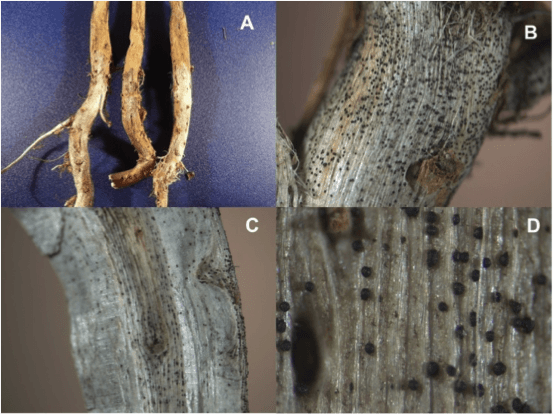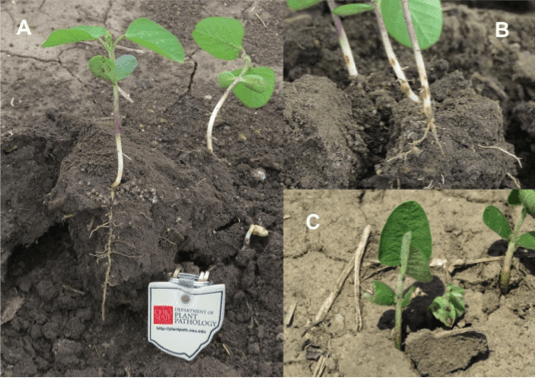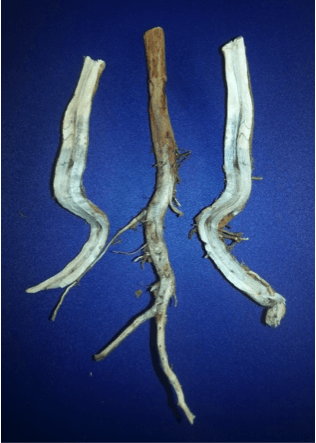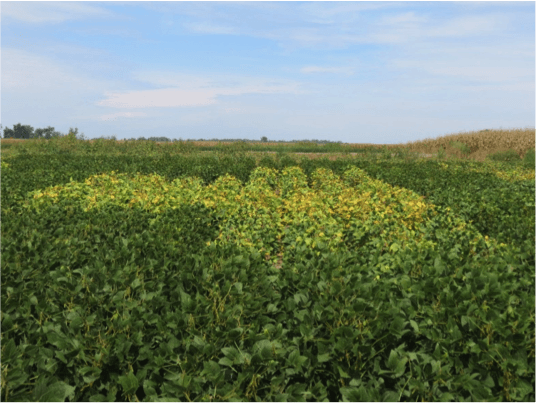Quick Facts | Download fact sheet
Charcoal Rot
Causal Agent:
Charcoal rot is caused by the fungus, Macrophomina phaseolina, which is reported to affect more than 500 species of plants, including corn, soybean, cotton, sunflower, and other agriculturally important crops. The fungus can survive in dry soil as microsclerotia (Figure 1) for 2 years or longer, but cannot survive more than 7 to 8 weeks in wet soils. Infection occurs early in the season on seedlings and the fungus grows slowly in the plant until hot dry weather occurs after flowering. Microsclerotia are the primary inoculum, which build up when soybean is planted continuously. Increase of inoculum in soybean fields is associated with more severe disease. M. phaseolina can be quantified as colony forming units (CFU) from soil and plant tissue (Figure 2) isolated on a semi-selective medium (Mengistu et al., 2009).

Figure 1. Macrophomina phaseolina microsclerotia in the outside (A, B and D) and inside (C) of soybean stems.
Symptoms and Signs:
The fungus M. phaseolina is a soil-borne pathogen and its spatial distribution in a field is aggregated, not homogeneous. If soybean plants get infected at the seedling stage, symptoms on the cotyledons are brown to black colored lesions (Fig. 3). If conditions are hot and dry, seedlings may die. On adult plants, M. phaseolina causes lesions on the root, stem, pod, and seed. Microsclerotia, which are produced in the vascular tissue and the pith, are responsible for the grey coloration of the stems and roots (Fig. 4). This silvery-grey color in the sub epidermal tissue of stem and roots is typical and is the source of the common name of the disease “charcoal rot.”

Figure 3. Macrophomina phaseolina affecting seedlings. A. Plants growing in plots infested with M. phaseolina. B. Red to brown lesions in stems of seedlings. C. Cotyledons with lesions caused by M. phaseolina.

Figure 4. Soybean lower stem and tap root colonized by Macrophomina phaseolina. Grey discoloration of plants as a result of microsclerotia formed inside the vascular system of infected plants.
Under hot and dry environmental conditions, soybean plants will wilt (Figure 5) and die prematurely with leaves remaining attached to petioles. Lower stems and taproots display a darker color than healthy plants, and also exhibit internal grey discoloration due to the presence of microsclerotia when stems are split. The fungus continues colonizing and producing microsclerotia after the soybean plant dies. This leads to the beginning of the cycle once again with an increase of the fungus population density in soil.

Figure 5. Charcoal rot symptoms in plots infested with Macrophomina phaseolina. Soybeans wilt and die prematurely.
Disease Management:
Cultural practices: Practices that reduce plant stress will contribute to charcoal rot management. These practices include: planting soybeans in no-tilled soil; maintaining soil moisture; ensuring adequate fertilization; reducing plant population density; and rotating to other crops to avoid continuous soybean cropping. Combining these cultural practices will reduce the buildup of inoculum and the impact charcoal rot can have on soybean yield.
There is no fungicide seed treatment effective for control of this disease. Even though partial resistance to charcoal rot has been identified, resistant commercial cultivars are not available yet.
